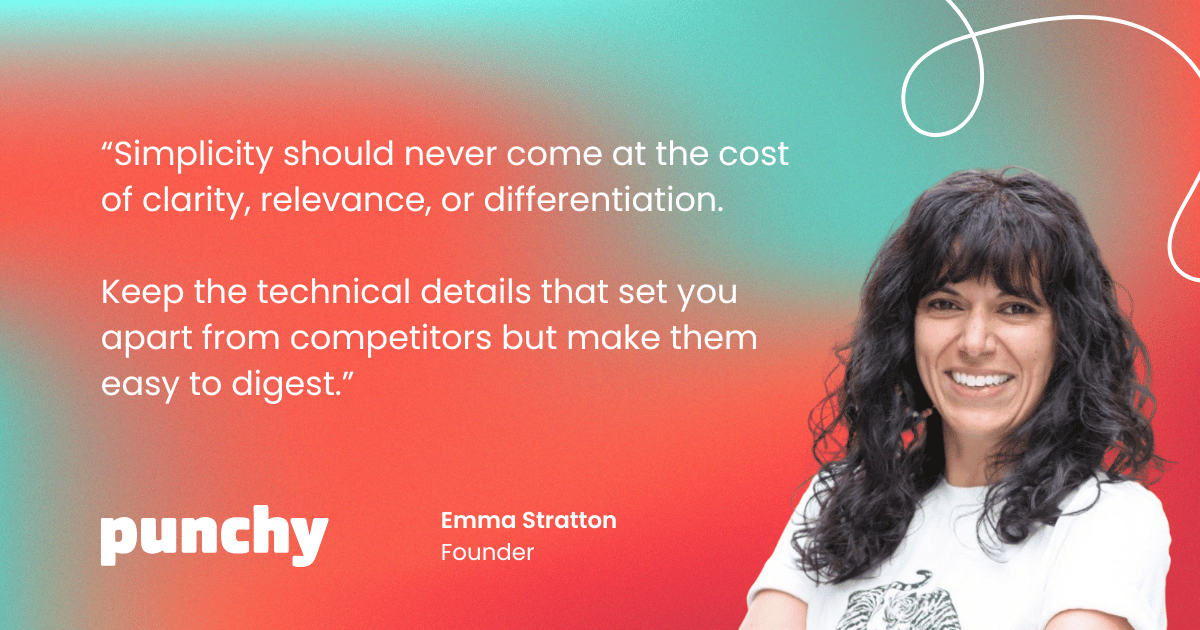This article is based on Emma Stratton’s brilliant presentation at the Positioning, Messaging, and Storytelling Summit. As a PMA member, you can enjoy the complete recording here.
I may be biased, but I’m obsessed with product messaging. It’s the number one way we bring our products’ awesomeness to life.
However, as cool as messaging is, let me be the first to admit that it’s hard.
The more I do it – and I’ve been at this for over a decade – the harder it seems to get. The market is increasingly flooded with competitors, and solutions are starting to overlap. It’s confusing for buyers and it’s a huge challenge for us to overcome.
That’s why I’m excited to share three techniques to punch up your messaging, plus a whole load of tips, that will make the messaging process a little easier for you.
Those three techniques?
- Be specific by mapping pains to desires
- Differentiate with just enough technical detail
- Be clear and conversational
Let’s get into it.
Why is product messaging so hard?
First, what makes product messaging so dang hard?
Let me share one of my favorite analogies. Imagine you have a friend who has never seen a sunset before. So, you tell your friend, “Oh my God, you have to experience the magic of a sunset! Just reimagine the sky with the power of a sunset.”
Your friend looks at you blankly and says, “Reimagine the sky? I don’t even know what that means!” They’re confused, so you try a different approach.
This time, you dive into the science of sunsets. You describe the sunlight traversing the atmosphere and all the physics behind it. But now, your friend is overwhelmed and thinks, “Whoa, maybe I don’t want to see a sunset after all.”
Two common pitfalls of product messaging
Now, that might seem like a silly analogy, but it illustrates two common pitfalls in product messaging – especially in tech.
Messaging often either takes the “reimagine the sky” route – vague, high-level, and fluffy, with sentences any tech company could say. Or, it goes in the opposite direction: super technical, hard to grasp, and straight into the weeds.
When you err too much in either direction, your buyers are left with two crucial questions unanswered:
- What the heck is this product?
- Why should I care?
How many times have you gone to a startup’s page or a tech company’s website and thought, “What do they even sell?” If your buyers don’t know what the product is, they definitely won’t know why they should care about it – and that’s a huge problem.
Bringing clarity to your product messaging
Now, let’s come back to that friend who’s never seen a sunset. To help them understand what a sunset is and why they should care, you might say something like, “Feel peace at the end of the day as the sun sinks into the horizon, turning the sky shades of pink, red, and orange.”
This sentence leads with why they should care about sunsets, then follows up with a simple explanation that they don’t need to be a scientist to understand.
On hearing this, there’s a good chance your friend would think, “Huh, cool. Maybe I’ll check out a sunset tonight,” and that’s exactly what we’re trying to get our buyers to do when they read our messaging.
We often think our messaging needs to be front-page-worthy and packed with excitement, innovation, and “wow” factor. In reality, our messaging just needs to make someone think, “Huh, cool.” We want them to understand what the product is and, more importantly, want to buy it.
With all that in mind, let’s dive into some techniques for creating messaging that will help buyers understand and want your products.
Technique #1: Be specific by mapping pains to desires
Let’s face it – no one in the real world talks like B2B tech companies.
We’ve all been guilty of typing out stuff like “Transform and accelerate your processes” and “Reduce risk with intelligent automation,” but do we really know what these terms mean? They’re so vague and abstract; the problem with this type of language is that it’s open to interpretation.
Consider a phrase like “boost productivity.” It’s not terrible, but it’s a bit vague. If you’re talking about tech for customer service agents and you say, “boost productivity,” it’s not clear what exactly that means.
So, what’s the antidote to all this vagueness and abstraction? Mapping your messaging to specific customer pain points and desires.
Rather than “boost productivity,” you could say, “Your agents will be able to quickly handle requests and automate approvals.” Potential customers can actually picture that happening. It’s much more specific and therefore much clearer and more appealing.
Here are a few more examples of vague and abstract B2B-isms and how they could be improved:
Let’s zoom in on the second example for a second. “Actionable forecasting” is a term companies often use to describe something great about their products, and it makes sense to them because they have all the context.
However, when a buyer – someone outside that bubble – reads “actionable forecasting,” chances are they’ll be left wondering, “What does that even mean?”
Now, if you tie that term to a specific customer pain – like the frustration of having to manually calculate weekly forecasts – and explain how the product takes care of that, suddenly it clicks. The buyer can now relate and might think, “Oh, I get it. I need that!”
This is the power of moving away from abstract language. When you pinpoint the exact problem you’re solving and clearly communicate how you solve it, your messaging becomes much more compelling.
When and how to get more specific
When you’re reviewing your messaging, be on the lookout for these red flags:
🚩 Abstract phrases that you can’t picture
🚩 Messaging that doesn’t mention the customer much
🚩 Anything that sounds like a tagline you’d see on a billboard
These are all signals that you need to get more specific. Here are three ways to do that:
✅ Show customers what they can do, be, or feel with your product
✅ Give concrete examples you can picture in your mind’s eye
✅ Reference a pain or desire that’s meaningful to your customer
When you find opportunities to add specificity, do it by showing what the customer will be able to do, feel, or achieve with your product. Paint a picture in their mind by giving concrete examples and always connect back to the customer’s pain or desire.
Technique #2: Differentiate with just enough technical detail
We all know we need to keep our messaging simple. However, there’s a common misconception that simplifying our messaging means dumbing it down – making it so simple that even your great-grandma could understand why AI matters, for example. But here’s the thing: your great-grandma probably isn’t your ideal buyer.
Simplicity shouldn’t be about stripping your message down to the bare basics. Instead, it should be about making your message super easy for your buyer to understand. Sometimes that means using more words, sometimes fewer. The key is not to strip out all the details, or else you end up with bland, undifferentiated statements.
Just look at these examples:
“Grow better”
– Hubspot
“Grow with our email marketing and CRM suite”
– Brevo
“We’re here to help you grow”
– Constant Contact
These companies are all in the same category, they’re all trying to tell SMBs about their number-one value, and they’re all saying basically the same thing. In other words, they’re failing to differentiate.
Simplicity should never come at the cost of clarity, relevance, or differentiation. Keep the technical details that set you apart from competitors but make them easy to digest.

Here’s an example using a fictional AI product for customer service reps. First, we have an oversimplified statement:
Sure, it’s simple and it sounds nice, but it’s also something dozens of other AI products could say. There’s no real differentiation here.
Now, let’s add some more detail:
Suddenly, we’re showing exactly how the AI works and offering something that sets it apart. That’s the power of detail.
Adding detail where it counts
A quick caveat: you don’t need this level of detail in every single social media post or marketing touchpoint.
It’s in your core messaging – your foundational documents and your messaging framework – that you want to get clear about what makes your product different and add just enough detail to help people understand that difference.
These documents serve as the source of truth for agencies, third parties, and PR teams. They’re the foundation that these teams will use to creatively bring your product’s differentiation to life. It all starts with your core messaging, so make sure your product’s unique selling points shine bright here.
Find the right altitude of technical detail
The challenge is figuring out how much detail to include. How much is too much? How much isn’t enough?
Unfortunately, there’s no one-size-fits-all answer. The amount of technical detail you need depends on your buyer, their level of tech-savviness, and the nature of your product.
It helps to think of it in terms of a sliding scale of altitude. At the high-altitude end, we have broad, high-level statements like “increase revenue” or “drive productivity.” While these might be valuable outcomes, they’re too abstract and far removed from what the product actually does.
On the opposite end, low-altitude messaging gets deep into the technical weeds – too much detail, too soon. This would be like explaining every technical feature of the product without connecting it to why it matters to the buyer.
Let’s take sandboxes as an example – those safe environments where developers can test code and play around without breaking live apps. “This sandbox will accelerate your company’s app development” is a high-altitude message. While it might be true that 10 steps down the road app development could speed up, it’s too broad and abstract as an opening gambit.
At the other end of the scale, going straight into how you can replicate bugs and tweak configurations in real time is too low-altitude and too technical for most buyers.
Find the right level of technical detail for your buyer
What you really want is to find the Goldilocks zone between high-altitude and low-altitude messaging. Of course, what that looks like will vary depending on who you're speaking to.
If your buyer is highly technical – maybe a developer or IT professional – you can include a bit more detail and let your message veer into the technical weeds a little. However, if your buyer is a CEO or a member of the C-suite, you’ll likely need to keep the message higher up, focusing more on value and less on the technical intricacies.
Saying something like “Safely test new features in a secure environment without disrupting business operations” might strike the right balance for an IT admin. It’s specific enough to give the buyer a clear understanding of what the sandbox does, without overwhelming them with unnecessary technical details.
To find the right balance, start by writing your draft, and then ask yourself: Is this at the right altitude? If the message is too high, ask how you can bring it down by adding more specifics. If it's too low, think about how you can elevate it to focus more on value. It’s all about finding that sweet spot that resonates with your audience.
When and how to differentiate with detail
Here are a few signs that you need to add some detail to your messaging to make it stand out from the crowd:
🚩 Generalities that could apply to many products: Think back to those super high-altitude statements like “grow your business.”
🚩 Leading with table stakes: For instance, if the messaging for your email automation platform says, “Send emails to all your customers,” that’s too obvious and doesn’t differentiate you from your competitors.
🚩 It’s unclear what you can do with the product or feature: If people don’t understand how your product can help them, how can you expect them to care about it?
If you spot any of these red flags in your messaging, it’s time to lower the altitude.
This is especially important if you’re operating in a mature market where your audience is already familiar with the product category. In this case, your goal is to help them understand what makes your product better or different from competitors.
Here’s how you can do that:
✅ Know what makes your product or feature unique: If you don’t have strong differentiation, you might need to make a positioning decision. Decide on a unique angle and highlight that.
✅ Find the right altitude of technical detail for your audience: Is it more technical or less technical?
✅ Use plain language to describe what’s different: Differentiating with detail doesn’t mean blasting your audience with jargon. Keep it simple and easy to understand.
Technique #3: Being clear and conversational
Even though we all hate jargon, buzzwords, and fluff, most of us are guilty of using them on occasion. I don’t know what it is about this industry, but jargon and fluff are everywhere. It’s like refined sugar – it sneaks into everything and it’s addictive. Jargon is especially common in tech, where everyone’s trying to get people excited about their innovations.
But here’s the problem: this kind of language bloats our messaging because it doesn’t actually say anything. Instead of clarity, all you get is vague, meaningless statements.
Jargon vs. industry-specific language
Now, you might be thinking, “But my buyers are technical and they use jargon all the time.” That’s a solid point, but there’s a difference between industry-specific language (which you may need to use) and jargon.
If you're unsure whether a term qualifies as jargon, run it through the ‘Is it jargon?’ test with three questions:
- Is this meaningful to my audience?
- Will it be universally understood by the people I'm trying to reach?
- Does it show that we understand their world and have credibility?
If the answer to all three is yes, go ahead and use it. If not, see if you can convey the same message in simpler terms.
When and how to eliminate jargon
Here are a few red flags to look out for in your messaging:
🚩 Jargon and corporate-speak
🚩 Phrases that sound good but don’t mean anything
🚩 Sentences that sound robotic when read out loud
And here are a few tips to fix them:
✅ Say it like you would at a barbecue
✅ Trade long fancy words for short plain ones
✅ Be thoughtful about technical and industry terms
Example: Transforming AI messaging
Let’s look at an example to illustrate this. Here’s the kind of message we’ve been seeing all over the place these last couple of years:
It’s filled with buzzwords like “supercharge,” “intelligent,” and “AI-powered,” which can sound exciting but vague.
The problem is that many of today’s buyers are experiencing AI paralysis – they’re overwhelmed by all the hype and don't know where to start when it comes to AI. To help them overcome this, you need to be clear about how your AI solution will make their lives easier.
Instead of bombarding them with even more buzzwords, try something more straightforward like this:
It’s not going to land you on the front page of any newspapers, but it’s clear, and it makes sense to your buyer. They’ll likely read that and think, “Huh, cool. I might check this out,” – and remember, that’s the goal.
Messaging is just the first step – it opens the door to your product and invites people to learn more. Once they’re interested, other assets and parts of your sales cycle will support their decision.
Your quick product messaging check
To wrap things up, here are three key principles to keep in mind for creating strong product messaging:
- Be specific
- Differentiate through detail
- Keep your language clear and conversational
Finally, here are three questions you can use to quickly check any product messaging you’ve written:
- Is it clear what the product is? If someone reads your message and can’t tell what the product is, they won’t stick around long enough to learn more.
- Does it address a meaningful desire or pain point? Your messaging should connect directly to a real problem or goal that your customer has. If it doesn’t speak to their needs, they won’t see the relevance.
- Is this different? If other companies could say the same thing, then you haven’t nailed down what makes your product unique. Go back and add more detail that highlights how your product stands out.
If your messaging checks all three boxes, you’re in a good spot.


















 Follow us on LinkedIn
Follow us on LinkedIn



.svg?v=aaaf5e025a)